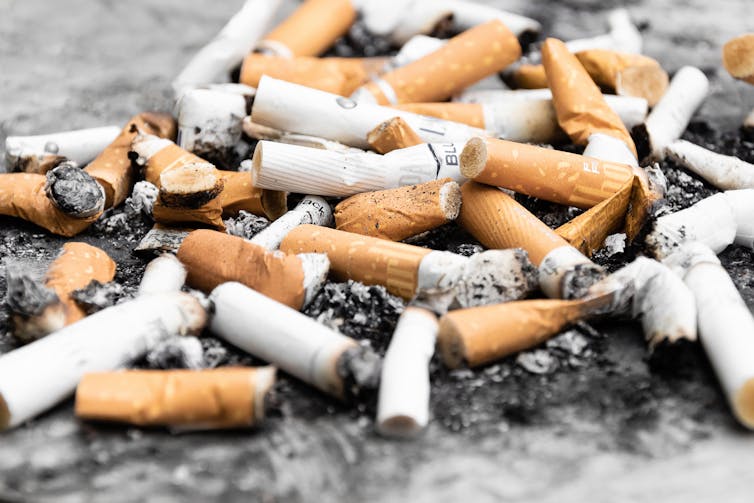
Vaping regularly makes headlines, with some campaigning to make e-cigarettes more available to help smokers quit, while others are keen to see vaping products banned, citing dangers, especially for teens.
So just how dangerous is it? We have undertaken an evidence check of vaping research. This included more than 100 sources on tobacco harm reduction, vaping prevalence and health effects, and what other countries are doing in response. Here’s what we found.
How does vaping compare to smoking?
Smoking is harmful. It’s the leading preventable cause of death in Australia. It causes 13% of all deaths, including from lung, mouth, throat and bladder cancer, emphysema, heart attack and stroke, to name just a few. People who smoke regularly and don’t quit lose about ten years of life compared with non-smokers.
Nicotine, a mild stimulant, is the active ingredient in both cigarettes and nicotine vaping products. It’s addictive but isn’t the cause of cancer or the other diseases related to smoking.
Ideally, people wouldn’t be addicted to nicotine, but having a safe supply without the deadly chemicals, for instance by using nicotine patches or gum, is safer than smoking. Making these other sources available is known as “harm reduction”.
Vaping is not risk-free, but several detailed reviews of the evidence plus a consensus of experts have all estimated it’s at least 95% safer to vape nicotine than to smoke tobacco. The risk of cancer from vaping, for example, has been estimated at less than 1%.
These reviews looked at the known dangerous chemicals in cigarettes, and found there were very few and in very small quantities in nicotine vapes. So the argument that we won’t see major health effects for a few more decades is causing more alarm than is necessary.

Is ‘everyone’ vaping these days?
Some are concerned about the use of vaping products by teens, but currently available statistics show very few teens vape regularly. Depending on the study, between 9.6% and 32% of 14-17-year-olds have tried vaping at some point in their lives.
But less than 2% of 14-17-year-olds say they have used vapes in the past year. This number doubled between 2016 and 2019, but is still much lower than the rates of teen smoking (3.2%) and teen alcohol use (32%).
It’s the same pattern we see with drugs other than alcohol: a proportion of people try them but only a very small proportion of those go on to use regularly or for a long time. Nearly 60% of people who try vaping only use once or twice.
Smoking rates in Australia have declined from 24% in 1991 to 11% in 2019 because we have introduced a number of very successful measures such as restricting sales and where people can smoke, putting up prices, introducing plain packaging, and improving education and access to treatment programs.
But it’s getting harder to encourage the remaining smokers to quit with the methods that have worked in the past. Those still smoking tend to be older, more socially disadvantaged, or have mental health problems.
Read more: My teen's vaping. What should I say? 3 expert tips on how to approach 'the talk'
Should we ban vapes?
So we have a bit of a dilemma. Vaping is much safer than smoking, so it would be helpful for adults to have access to it as an alternative to cigarettes. That means we need to make them more available and accessible.
But ideally we don’t want teens who don’t already smoke to start regular vaping. This has led some to call for a “crackdown” on vaping.
But we know from a long history of drug prohibition - like alcohol prohibition in the 1920s - that banning or restricting vaping could actually do more harm than good.
Banning drugs doesn’t stop people using them - more than 43% of Australians have tried an illicit drug at least once. And it has very little impact on the availability of drugs.
But prohibition does have a number of unintended consequences, including driving drugs underground and creating a black market or increasing harms as people switch to other drugs, which are often more dangerous.
The black market makes drugs more dangerous because there is no way to control quality. And it makes it easier, not harder, for teens to access them, because there are no restrictions on who can sell or buy them.
Read more: Learning about the health risks of vaping can encourage young vapers to rethink their habit
Are our current laws working?
In 2021, Australia made it illegal to possess and use nicotine vaping products without a prescription. We are the only country in the world to take this path.
The problem is even after more than a year of this law, only 8.6% of people vaping nicotine have a prescription, meaning more than 90% buy them illegally.
Anecdotal reports even suggest an increase in popularity of vaping among teens since these laws were introduced. At best, they are not helping.
It may seem counterintuitive, but the way to reduce the black market is to make quality-controlled vapes and liquids more widely available, but restricted to adults. If people could access vaping products legally they wouldn’t buy them on the black market and the black market would decline.
We also know from many studies on drug education in schools that when kids get accurate, non-sensationalised information about drugs they tend to make healthier decisions. Sensationalised information can have the opposite effect and increase interest in drugs. So better education in schools and for parents and teachers is also needed, so they know how to talk to kids about vaping and what to do if they know someone is vaping.
What have other countries done?
Other countries allow vapes to be legally sold without a prescription, but impose strict quality controls and do not allow the sale of products to people under a minimum age. This is similar to our regulation of cigarettes and alcohol.
The United Kingdom has minimum standards on manufacturing, as well as restrictions on purchase age and where people can vape.
Aotearoa New Zealand introduced a unique plan to reduce smoking rates by imposing a lifetime ban on buying cigarettes. Anyone born after January 1 2009 will never be able to buy cigarettes, so the minimum age you can legally smoke keeps increasing. At the same time, NZ increased access to vaping products under strict regulations on manufacture, purchase and use.
As of late last year, all US states require sellers to have a retail licence, and sales to people under 21 are banned. There are also restrictions on where people can vape.
A recent study modelled the impact of increasing access to nicotine vaping products in Australia. It found it’s likely there would be significant public health benefits by relaxing the current restrictive policies and increasing access to nicotine vaping products for adults.
The question is not whether we should discourage teens from using vaping products or whether we should allow wider accessibility to vaping products for adults as an alternative to smoking. The answer to both those questions is yes.
The key question is how do we do both effectively without one policy jeopardising the outcomes of the other?
If we took a pragmatic harm-reduction approach, as other countries have done, we could use our very successful model of regulation of tobacco products as a template to achieve both outcomes.
Read more: It's safest to avoid e-cigarettes altogether – unless vaping is helping you quit smoking
Nicole Lee works as a consultant in the health sector and a psychologist in private practice. She has previously received funding by Australian and state governments, NHMRC and other bodies for evaluation and research into alcohol and other drug prevention and treatment.
Brigid Clancy is an Associate at 360Edge, a drug and alcohol consultancy company.
This article was originally published on The Conversation. Read the original article.







